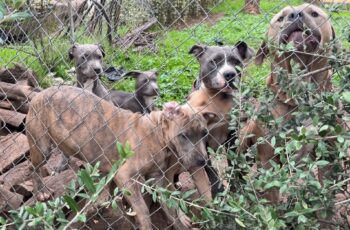Pythiosis is a rare but emerging disease in dogs, humans, horses, and other mammals. This illness was originally described by British veterinarians studying horses with skin lesions in India in 1884. It has since been identified as an illness that is endemic to tropical and subtropical regions of the world, including Thailand, India, Brazil, and the U.S. states that border the Gulf of Mexico. It is characterized by either non-healing sores on the skin, or the rapid growth of lesions in the dog’s stomach and intestine – masses that quickly obstruct the digestive tract.
What is pythiosis caused by?
Pythiosis is caused by the oomycete Pythium insidiosum. Oomycetes (pronounced oh-uh-MY-seats) are organisms that act and look like a fungus but are more closely related to algae. They are often referred to as “water molds.”
P. insidiosum needs water to complete its life cycle. It is typically found in stagnant water, such as that found in ponds, swamps, and bayous, but can also be found in moist soil. P. insidiosum is attracted to grasses and other aquatic vegetation, human and horse hair, and the skin of mammals.
In the United States, Pythium insidiosum is found primarily in the southeastern region of the country and includes the states of Florida, Texas, Arkansas, Louisiana, Georgia, Mississippi, Alabama, and North and South Carolina. However, cases of pythiosis have been diagnosed in other parts of the country, including as far north as Wisconsin and as far west as California. Pythiosis case reports have significantly increased in the past decade.
Finding this organism in ponds, swamps, and bayous makes sense when we think about the typical tropical and subtropical geographic distribution of pythiosis. It is not entirely understood why we are now diagnosing pythiosis in animals living in arid or colder regions of the country and that have no travel history outside of their home area. There is some speculation that there may be a connection between agricultural irrigation practices in these regions and exposure to P. insidiosum.
Any breed of dog may develop pythiosis. Most dogs that develop pythiosis are young (less than 3 years old) and tend to be hunting or sporting breed dogs that spend time in water or marshy areas. A higher prevalence of the disease among German Shepherds has been documented in the United States. It is not known why German Shepherds are over-represented.
Symptoms of pythiosis in dogs
There are two forms of pythiosis that are known to develop in dogs: the cutaneous form and the gastrointestinal form. Dogs can contract the cutaneous form when a wound on their skin becomes exposed to the oomycete. Oomycetes cannot invade intact or non-wounded skin. The gastrointestinal form is contracted when dogs swallow water or eat aquatic vegetation contaminated with oomycetes.
In the cutaneous form of the disease, a dog will have a non-healing wound that does not respond to antibiotics. The wound will often grow in size and may develop ulcers that drain pus. Initially, it can look similar to an acral lick granuloma, but tissue death (necrosis) follows, with the affected skin turning black.

In the gastrointestinal form of pythiosis, a dog may exhibit vomiting or diarrhea early in the disease process. Vomiting may occur if the stomach or small intestine are affected. Diarrhea may occur if the colon is affected. The diarrhea may progress to watery and bloody stool. A dog’s appetite will decrease or he may stop eating entirely as the disease progresses. Affected dogs will lose weight because their ability to absorb nutrients is impaired.
Pythiosis of the gastrointestinal tract may cause abnormal thickening of the esophagus, stomach, and small or large intestine. Masses may develop at these sites and these masses may be felt by your veterinarian on abdominal palpation.The infection may spread to adjacent abdominal organs, including the pancreas, gallbladder, liver, or uterus.
How is pythiosis in dogs diagnosed?
There are two tests that your veterinarian may order if she suspects pythiosis. The first is a blood test called a Pythium insidiosum ELISA test. This tests for antibodies in your dog’s blood, indicating exposure to the P. insidiosum organism.
The second test is histopathology of a biopsy sample obtained from one or more lesions. For the cutaneous form, biopsy samples are taken from one or more skin lesions. For the gastrointestinal form, an abdominal exploratory surgery is performed and biopsy samples are taken from any abdominal masses or thickened areas of the gastrointestinal tract. The biopsy samples will need to be stained with a special stain called GMS so that the P. insidiosum organism can be seen under a microscope.
Treatment for pythiosis in dogs
Treatment involves wide surgical excision of the affected skin or section of the gastrointestinal tract. If the skin lesion is on a limb or the tail, then the limb or tail may need to be amputated. For the gastrointestinal form, affected sections of the small or large intestine would need to be resected. Dogs are then treated with antifungal medications for two to four months after surgical removal of the lesions. In many cases, the lesions are so large and extensive that surgical excision is not possible.
For cases where surgical excision is not possible, dogs are treated with a lengthy course of antifungal medications. Combination therapy with itraconazole and terbinafine with or without amphotericin B are often used. Because P. insidiosum is not a fungus (but looks and acts like one), antifungal therapy alone is successful in treating only about 20% of dogs with pythiosis.
A case report published in 2019 described the successful treatment of three dogs with pythiosis of the colon using a combination of itraconazole, terbinafine, and prednisone. All three of these dogs had complete resolution of their clinical signs, regression of their colonic masses, and achieved negative titers for P. insidiosum.
Another case report published in 2011 described the successful treatment of one dog with pythiosis of the stomach and small intestine using a combination of itraconazole, terbinafine, and mefenoxam. Mefenoxam is an agricultural fungicide. It is used to control oomycetes that are pathogenic to agricultural crops, grasses, and ornamental plants. The Environmental Protection Agency (EPA) had to complete safety studies of mefenoxam on mammals as part of the approval process for this fungicide. This is what gave the authors of this report the idea to try mefenoxam.
A case report published in 2020 also examined the treatment protocol of itraconazole, terbinafine, and mefenoxam. Five dogs with gastrointestinal pythiosis and one dog with cutaneous pythiosis were treated with this protocol. This report found that use of mefenoxam may improve outcomes for dogs with gastrointestinal pythiosis.
Desperately seeking better treatments
As of the publication date of this article, the University of Florida College of Veterinary Medicine is recruiting dogs diagnosed with pythiosis for a pilot study of mefenoxam. People interested in enrolling their dogs in this study should contact the University of Florida Small Animal Hospital at (352) 392-2235 or complete the study interest form at https://research.vetmed.ufl.edu/clinical-trials/contact-us/ to see if their dog qualifies.
An immunotherapy option is available for treating pythiosis in dogs. Pythium insidiosum antigen (PIA) is a therapeutic vaccine that elicits a change in how a dog’s immune system responds to P. insidiosum in the body. Because this is a therapeutic vaccine, it does not prevent infection with P. insidiosum. PIA is most effective when given early in the course of the disease. It has been shown to be effective in 55% of dogs treated.
Another therapy being studied by the University of Florida College of Veterinary Medicine is treatment with a heat-killed bacteria called Actinomycetales. As with the mefenoxam study, people interested in enrolling their dog in the study should contact UF CVM’s Small Animal Hospital or complete the study interest form online.
How long can a dog with a pythium infection live? The prognosis for dogs with pythiosis, especially advanced cases, is not good. One study of 10 cases reported a post-diagnosis median survival time of 26 days, and the condition was fatal in all 10 dogs. But new treatments on the horizon may change the outlook for dogs with this disease. Prompt recognition of symptoms leading to an early diagnosis – before a case becomes chronic – is the key to successful treatment. If your dog has been a visitor to wetlands and has a non-healing sore, or has begun to lose weight or experience vomiting or diarrhea, see your veterinarian as soon as possible.


